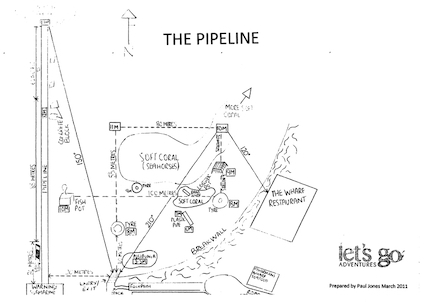You have 0 product(s) in your cart.
The Pipeline

As with all shore dives within the bay diving on the high tide slack is a must. The dive is a great dive during the day and also an incredible night dive. The dive is arguably one of the best Macro dives in NSW and definitely a photographer’s joy. Simply put; it’s fantastic for any diver who wants to enjoy ‘critters’ in a relaxed atmosphere that does not pose the challenge of incredible depth or harsh conditions.
The actual pipeline is about 25m to the west of the entrance steps and can be easily sighted from the water surface. It is marked by a warning sign highlighting the submerged pipe to water craft and runs generally north of the sign out into the bay for about 250 meters and to a depth of about 18 meters. North east of the end of the pipe is a small ledge similar to that at Fly Point. Local Marine life can be found in abundance along the ledge and include a great variety of species such as pineapple fish, wobbegongs and rock lobsters.
Macro life exists in abundance along the full length of the pipeline. At various stages to the east soft corals and sponges of wonderful colour and variety are home to sea horses, Sea Pens, pipefish, cuttlefish, moray eels and tropical fish. Of interest to all divers are the nudibranchs.
Local scientist, David Harasti, has spent several years studying and cataloguing the local species, an accomplished photographer, his photo gallery of the species found in Nelson Bay can be viewed on the Species database. He uses coloured plastic tags in the water as part of his study and should not be mistaken as trash and removed.
On entering the water swim out over the rocks and sea grasses down a gentle slope in a generally northerly direction. About 6-8m depth and 10m from shore, sponges begin and corrals start to become common. In this initial short distance you’ve entered the domain of the sea horses, present all year round. They are small (6-8cm) and their colouring blends in with the native corals and sponges, look closely. After perusing the sponge gardens head over to the macro on the pipeline (to the West) and enjoy the incredible colours and diverse ecosystems around the pipes’ concrete blocks. Be mindful of the sand covering the pipeline about 100m from shore. To exit swing around south and head back to shore. The steps are easily located from the water and your best egress.
An alternative is to enter the water and follow the pipeline out to its end. Northeast of the end you will find the aforementioned ledge. This is a long dive and be mindful of the extra depth. This dive takes about an hour.
Due to the incredible diversity and size of this magnificent site, a single dive will not allow you to enjoy all it has to offer.
If you do get lost, head south. The shore is easy to get back to and the exit steps are at the bottom of the path behind the fish co op. After your dive, head back to lets go for a hot shower and gear clean.
Pipeline Dive Plan
The pipeline is the most convenient dive site to the Let’s Go Adventures shop. A short 150 metre walk brings you directly to the entry/exit point. Parking is available outside the dive shop.
The entry/exit point is easily identified at the end of the footpath adjacent to ‘Nelson Bay Seafoods’. Head down a small track that is cleared through the grass to a purpose built rock staircase that allows easy access directly into the water.
This area is often frequented with boat traffic so it is advisable only to surface within the shallows. If you are forced to surface from the deeper areas it is recommended to use a surface marker buoy and always look up and listen. If you follow the breakwall take care to avoid fishing line: a knife is highly recommended. The pipeline is home to various Rays and Octopi (including blue rings), so please pay attention to your hand placement.
Plan 1 – For a relaxing, easily navigated dive enter the water and surface swim west to the pipeline, identified by a large yellow sign on the shore. Descend and locate the pipeline (a barnacle encrusted black rubber pipe) and head north, following the pipeline. Continue following the pipe due north until it heads under the sea bed, where a large coral sponge garden is revealed at approx 14 metres. After exploring this area, return south along the pipeline and exit where you entranced. Take note of your air gauges on the way out and turn around if you reach half before reaching the end of the pipeline.
Plan 2 – For a more exciting and harder navigational dive head along the pipeline as per plan 1 until you reach 10 metres, where you will find a patch of coral on the eastern side of the pipeline. From here head directly east until you reach soft coral where a wide range of species are located, including seahorses, pipefish and cuttlefish. The seahorses are often found resting on the cauliflower corals. After exploring this area head south east along a large sandy area, looking out for various rays and octopi. Upon reaching the breakwall follow it south (or west, depending on where you locate it) until you hit an area of posidonia (sea grass) at 3-5 metres. At the western end of the posidonia surface at your entry point.
The pipeline is a large dive site and there is a large amount of aquatic life and features to discover. It is recommended to dive the pipeline 20 minutes after the high tide to avoid strong currents and for the best visibility.